 This article is inspired by a question I received through Facebook; "Why do we have to rotate one of the subwoofers in an inverted stack cardioid array? Can't we achieve the same effect with all subwoofers facing the same direction and delay only?"
This article is inspired by a question I received through Facebook; "Why do we have to rotate one of the subwoofers in an inverted stack cardioid array? Can't we achieve the same effect with all subwoofers facing the same direction and delay only?"
Well, not that I'm aware of. The problem with delay is that it results in a moving target.
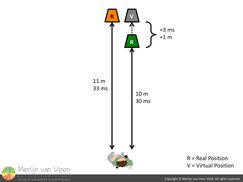 figure 1Figure 1 shows two real loudspeakers at a physical distance of 11 m and 10 m to the listener. If we assume that sound requires roughly 3 ms at room temperature to cross a 1-meter distance, we could also say that both loudspeakers would take 33 ms and 30 ms respectively to arrive at the listener's position.
figure 1Figure 1 shows two real loudspeakers at a physical distance of 11 m and 10 m to the listener. If we assume that sound requires roughly 3 ms at room temperature to cross a 1-meter distance, we could also say that both loudspeakers would take 33 ms and 30 ms respectively to arrive at the listener's position.
Without any further signal processing, this would mean that the closest loudspeaker would be heard first. In this case, that loudspeaker would also be marginally louder, by approximately 1 dB, because it's 10% closer. Suffices to say, that for the sake of this article, this level difference is negligible.
However, if we give this leading loudspeaker a virtual "push" by means of delay, both loudspeakers will be heard simultaneously. From the listener's point of view, this virtual "push" moves the loudspeaker in the opposite direction as if the loudspeaker was actually at that very position which brings us to the caveat.
Delay always moves the loudspeaker in the opposite direction, away from the listener. Hence, the moving target.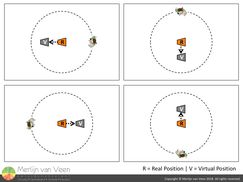 figure 2Figure 2 shows the virtual, perceived position of a real loudspeaker after applying delay, based on the position of the listener. Notice how the virtual loudspeaker doesn't remain stationary unlike real, actual physical displacement where the loudspeaker only moves in one direction exclusively. It all depends on how you look at it.
figure 2Figure 2 shows the virtual, perceived position of a real loudspeaker after applying delay, based on the position of the listener. Notice how the virtual loudspeaker doesn't remain stationary unlike real, actual physical displacement where the loudspeaker only moves in one direction exclusively. It all depends on how you look at it.
Now, in order to achieve cancellation at a given frequency, a 180° phase offset is mandatory. This could be achieved by means of physical displacement, i.e., half a wavelength or delay, i.e., half a time period.
If we build an inverted stack gradient array, colloquially referred to as Cardioid Subwoofer Array (CSA), where all subwoofers face the same direction, using delay only, this poses a problem.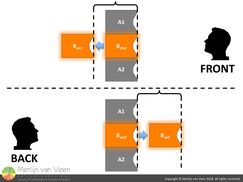 figure 3Figure 3 shows such an array where delay will effectively move subwoofer B in the opposite direction from the listener's point of view. The virtual "push".
figure 3Figure 3 shows such an array where delay will effectively move subwoofer B in the opposite direction from the listener's point of view. The virtual "push".
Regardless whether we observe the array from the front or the back, on either side both A-subwoofers will lead and subwoofer B will arrive late. A symmetrical outcome.
When the introduced amount of delay equals half a period for a given frequency which is required for cancellation, this will result in cancellation on both sides which clearly isn't cardioid.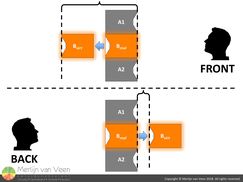 figure 4However, if we physically rotate the middle B-subwoofer, a unidirectional displacement regardless of how we look at the array, things change.
figure 4However, if we physically rotate the middle B-subwoofer, a unidirectional displacement regardless of how we look at the array, things change.
Figure 4 shows such an array and now the same amount of delay results in a vastly different outcome. Behind the array, all loudspeakers are heard effectively simultaneously.
The grills of both A-subwoofers and the virtual B-subwoofer, after the "push", almost live on the same imaginary line. Conversely, in front of the array, the effective displacement between the loudspeakers is now much bigger than before the "push".
Unlike before, where all subwoofers were facing the same direction, we no longer have a symmetrical outcome. On both sides of the array there is now a unique situation.
How to proceed from here and turn this into an actual cardioid array is beyond the scope of this article. Please consult the Subwoofer Array Designer manual on how to achieve this. The main focus of this article is that delay results in moving targets.
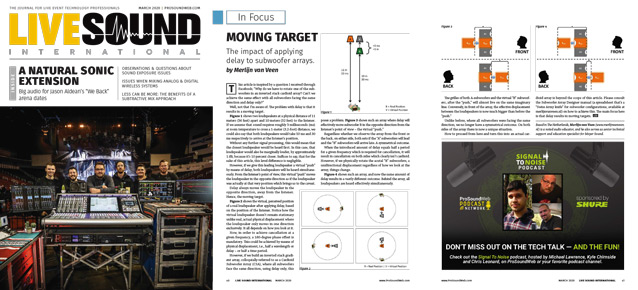
This article is also featured in the March 2020 issue of Live Sound International magazine.
